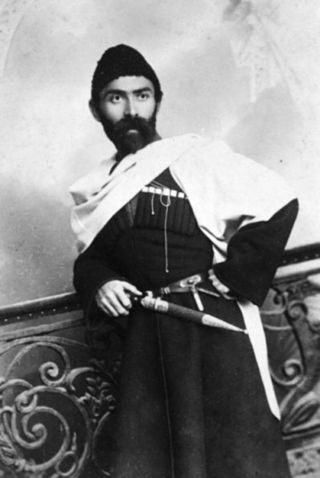Top Qs
Timeline
Chat
Perspective
Bashlyk
Traditional headgear From Wikipedia, the free encyclopedia
Remove ads
Remove ads
A bashlyk, also spelled bashlik,[a] is a traditional Turkic, Caucasian, Iranian, and Cossack cone-shaped hooded headdress, usually of leather, felt or wool, featuring a round topped bonnet with lappets for wrapping around the neck. Local versions determine the trim, which may consist of decorative cords, embroidery, jewelry, metallized strings, fur balls or tassels. Among dozens of versions are winter bashlyks worn atop regular headdress, cotton bashlyks, homeknitted bashlyks, silk bashlyks, scarf bashlyks, down bashlyks, dress bashlyks, jumpsuit-type bashlyks, etc. Bashlyks are used as traditional folk garment, and as uniform headdress.[1][2]


A variation of bashlyk is the kalpak (qalpaq), a cone-shaped headdress without lappets, mostly made of leather, felt or wool,[3] and the malahai, also known as the tymak, a curved cone-shaped headdress, either with or without lappets, mostly made of leather, and occasionally with a fur-wrapping, originally worn by most inhabitants of the Idel-Ural, but nowadays mostly reduced to the Bashkirs.[4] It also went on to inspire the budenovka in the USSR.[5]

Remove ads
History
Summarize
Perspective
The origins of this conical headgear can possibly be traced back to the oldest equestrian nomadic peoples in antiquity. It may have originated as a type of sauna hat to preserve body heat, due to most nomadic cultures having practiced a variety of the steam bath rather than traditional bathing, with the upright length of the hood eventually becoming a symbol of social status among some peoples.[6]

The Scythians are often depicted in ancient depictions with hoods, which were then called Phrygian caps, after a similar headgear of the Anatolian Phrygians. Although named after the Phrygians, the long pointed hoods were already widespread among the Scythians, Cimmerians, Argippaeans and Sarmatians. The Central Asian Sakas, used similar, but usually much higher hoods, as ancient depictions and archaeological finds show. Research in Turkology and Iranian studies often assumes a continuity between the antecedent of the Phrygian cap and the Bashlyk, often referring to this ancient headgear with the word Bashlyk exclusively.[7][8]

In modern times, bashlyks became fashionable in Russia in 1830-1840, after the Napoleonic Wars with significant participation of the Bashkir cavalry. By the 1862 bashlyks were made a uniform headdress in Cossack armies, and later in other branches of Russian armed forces. The military bashlyk was bright yellow camel wool, with a yellow band. Officer bashlyks had gold or silver band. In the Russian army, bashlyks lasted till 1917, when they became a trademark of White Army officers and Red Army cavalry.[9]
Remove ads
Gallery
- Orenburg Cossacks wearing bashlyks and cloaks (on the left), 1839
- A sketch of an old man by Vasnetsov, 1871
- A sketch of a Don Cossack with bashlyk on, taken in Paris during the campaign of 1815
- The same Don Cossack with bashlyk off, on the back
- 19th century depiction of Bashkirs raiding Paris, all depicted wearing Bashlyks and Malahais
Notes
- Karachay-Balkar: Başlıq, Adyghe: Shkharkhon, Abkhaz: qtarpá, Chechen: Ċukkuiy, Georgian: ყაბალახი, q'abalakhi, Ossetian: басылыхъхъ, basylyqq, Crimean Tatar: Başlıq, Tatar: Başlıq, Turkish: Başlık; "baş" - head, "-lıq" (Tatar) / "-lık" (Turkish) - derivative suffix.
See also
References
Wikiwand - on
Seamless Wikipedia browsing. On steroids.
Remove ads





